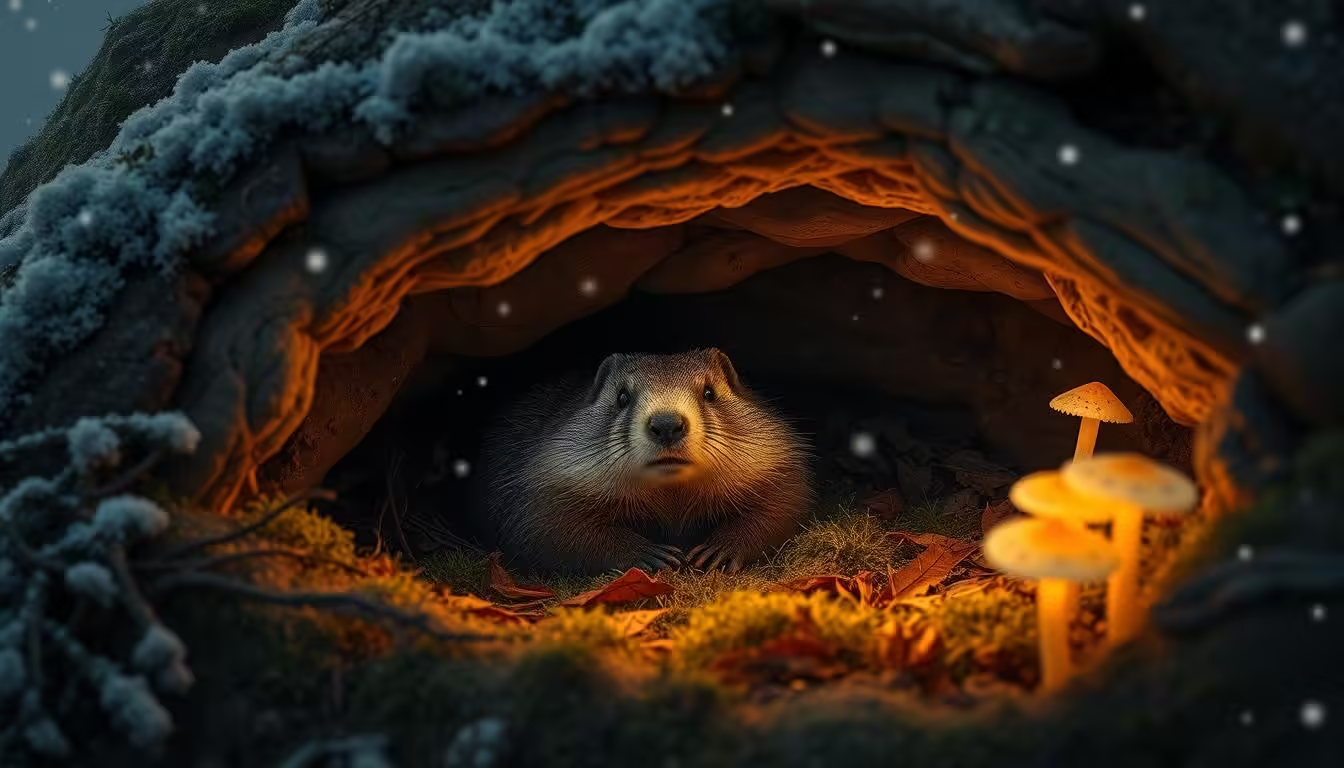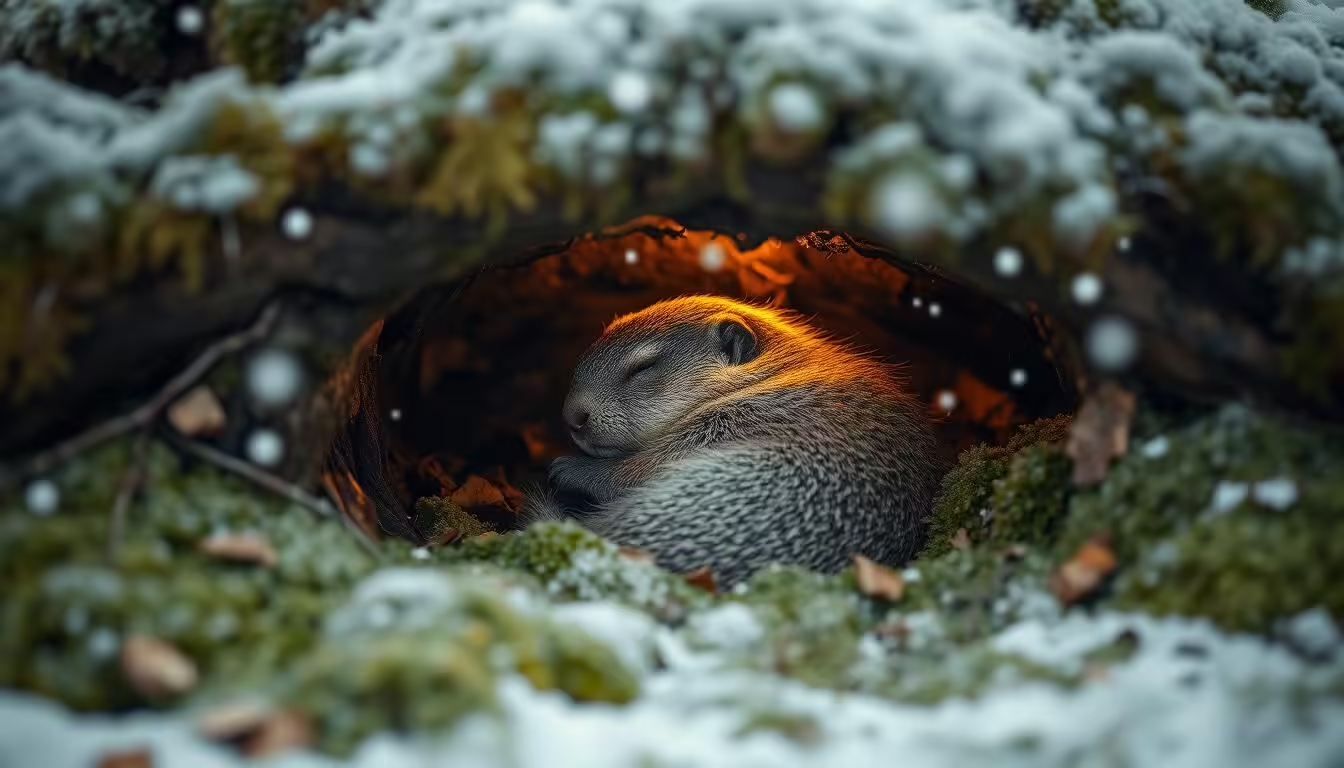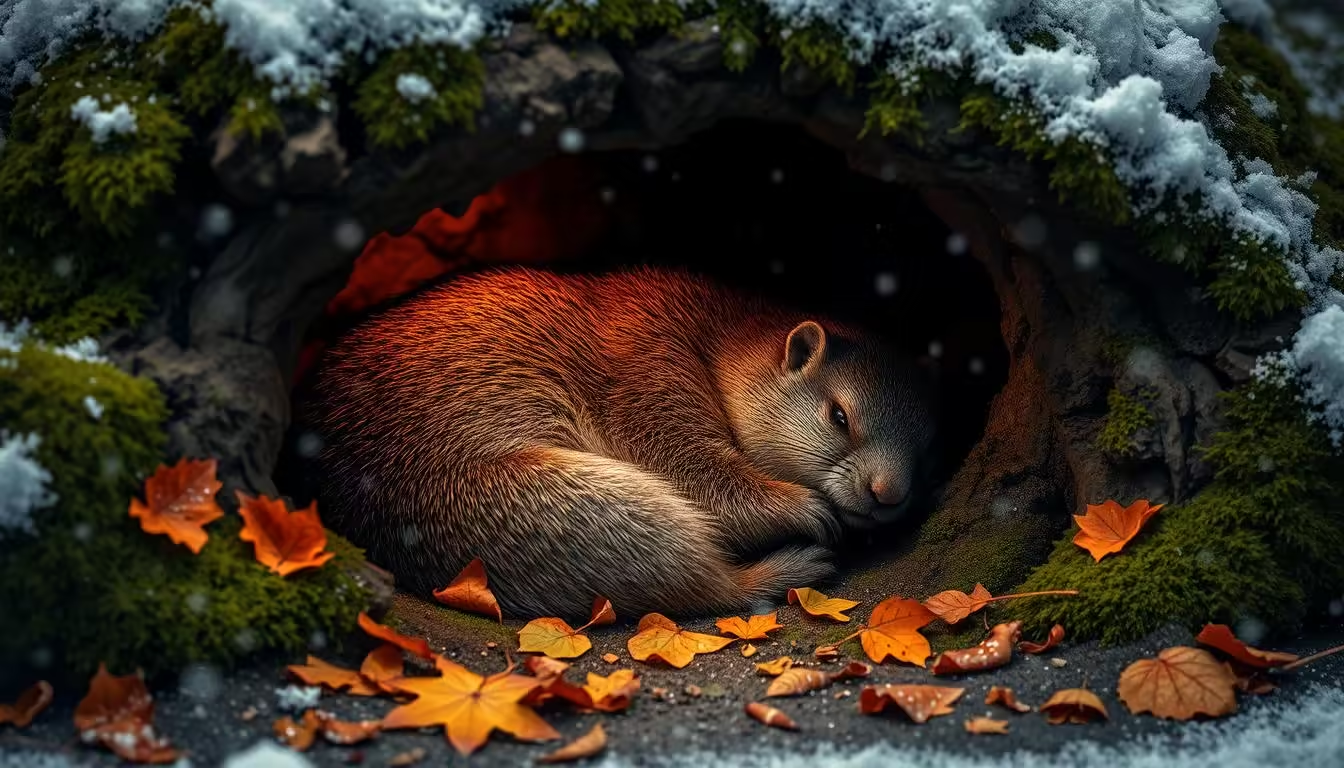Groundhogs, also known as woodchucks or whistle pigs, are true hibernators. They sleep deeply to get through harsh winters. Their body temperature drops from 98°F to as low as 38°F. Their heart rate slows down from 80-100 beats per minute to just 4-5 beats per minute.
Groundhogs belong to the squirrel family. They are great at digging underground. Before hibernation, they eat a lot to store fat. This fat is their energy source during their long winter sleep.
Key Takeaways
- Groundhogs are true hibernators that enter a deep winter sleep to survive harsh winters.
- They significantly reduce their body temperature and heart rate during hibernation.
- Groundhogs are well-adapted for burrowing underground and prepare for hibernation by building up fat reserves.
- Groundhogs are members of the squirrel family and are found throughout the eastern and mid-western United States.
- Understanding the science behind groundhog hibernation can provide insights into their survival strategies and adaptations.
What is Hibernation?
Hibernation is a natural wonder seen in many animals, like the groundhog. It’s a way for them to save energy when food is scarce and the weather is harsh. Groundhogs and others like them change a lot to get through the winter.
Defining the Term
Hibernation means being very still and using less energy. Animals’ body temperatures drop, and their breathing and heart rates slow down. This helps them last longer without food.
Types of Hibernation
Not all hibernating animals change as much. Some, called “true hibernators,” change a lot. Others, called “facultative hibernators,” only change a little when they need to.
- Obligate hibernators: These animals always go into deep hibernation, no matter the weather.
- Facultative hibernators: These animals only hibernate when they’re hungry or it’s very cold.
Groundhogs are true hibernators because they change a lot during their winter sleep.
“Hibernation is a state of reduced metabolism, similar to a very deep sleep, enabling mammals to survive periods of food scarcity.”
Why Do Groundhogs Hibernate?
Groundhogs, also known as woodchucks, hibernate to survive the harsh winter. They have less food to eat during this time. So, they sleep to save energy and use stored fat.
Survival Strategy
Hibernation helps groundhogs deal with cold weather and finding food. They sleep deeply, which slows down their metabolism. This lets them stay warm and safe in their burrows all winter.
Seasonal Food Availability
In warmer months, groundhogs eat grasses, veggies, and flowers. But when it gets colder, these foods are hard to find. Hibernation lets them wait for spring when food is plentiful again.
They know when to start hibernating because of the shorter days and colder weather. This natural instinct helps them get ready for winter.
“Hibernation is a remarkable evolutionary adaptation that allows groundhogs to thrive in temperate climates with marked seasonal changes in resource availability.”
The Science of Groundhog Hibernation
Groundhogs, also known as woodchucks, are amazing hibernators. They change a lot to survive the cold winter. Their body temperature goes from 98°F to just 38°F.
Their heart rate also drops a lot. It goes from 80-100 beats per minute to just 4-5 beats per minute.
During hibernation, their breathing rate slows down. This helps them save energy. It’s a key part of their survival plan, letting them make it through the winter without food.
But, these groundhogs don’t sleep the whole time. They wake up sometimes to move around and even go to the bathroom.
Periodic Arousal
This helps prevent damage to their organs and muscles. It’s because of staying still for too long.
The groundhog’s ability to change its groundhog sleep and hibernation process is truly amazing. It shows how these animals have adapted to their tough environment.
“Groundhogs have dramatic annual biological rhythms, making them excellent for various research studies.”
Indeed, the groundhog’s unique body has made it a great subject for science. Studies on them have given us important insights into health in animals and humans.
Groundhog Biology and Adaptations
Groundhogs, also known as woodchucks, are fascinating hibernating mammals. They have evolved remarkable physical and behavioral adaptations to survive the harsh winter months. Their compact, chunky bodies are supported by short, strong legs and long, curved claws. These animal hibernators are well-equipped for digging extensive burrow systems that serve as their winter homes.
Typically, groundhogs have a grizzled brownish-gray fur coat. Rare occurrences of albino or melanistic individuals do happen. Their eyes, ears, and nose are positioned towards the top of their head. This allows them to remain concealed in their burrows while keeping a watchful eye for potential threats. This strategic placement of their sensory organs is a crucial groundhog winter behavior adaptation.
Physical Characteristics
Groundhogs can weigh anywhere between 5 to 15 pounds. They measure 16 to 26 inches in length. These compact, stout-bodied creatures are well-suited for their underground lifestyle. Their short, powerful limbs and sharp claws provide the perfect tools for digging and maintaining their extensive burrow systems.
Behavioral Changes
As the days grow shorter and the temperature starts to drop, groundhog winter behavior changes dramatically. Groundhogs exhibit increased feeding behavior during the fall. They pack on fat reserves to sustain them through the long hibernation period. They also meticulously prepare their winter burrows, ensuring they are well-insulated and stocked with food caches to weather the cold months ahead.
| Characteristic | Value |
|---|---|
| Weight Range | 5–15 lbs |
| Length | 16–26 inches |
| Lifespan | 4 to 6 years in the wild |
| Daily Summer Consumption | Up to 1.5 lbs of vegetation |
| Litter Size | 2–6 young per year |
| Weight Gain per Day | 11.5–20 grams |
| Burrow Depth | 4 to 5 feet beneath the surface |
| Burrow Length | Up to 30 feet |
Winter Habitat of Groundhogs
As winter gets closer, groundhogs (also known as woodchucks) start getting ready for hibernation. They build big burrow systems that act as their winter home. These burrows keep them safe and warm from the cold.
Burrow Construction
Groundhog burrows can go as deep as 6 feet and be up to 20 feet wide. They have many entrances and rooms. Before hibernation, they block the burrow’s entrances with dirt. This keeps the inside warm, around 50°F, all winter.
Environmental Factors
- Groundhog burrows are often in wooded or brushy areas, offering better protection.
- These hibernating mammals usually weigh between 5 to 10 pounds, with males being slightly larger.
- Groundhogs live about 3 to 4 years and can run up to 10 miles per hour.
- During hibernation, groundhogs spend up to 80% of their time in the dark. They only come out briefly to eat, which makes up about 23% of their time.
By building these complex burrows and changing their behavior, groundhogs make it through the winter. This is a key part of their yearly cycle.
The Hibernation Cycle
Groundhogs truly hibernate, changing their bodies to survive winter. Their hibernation starts in late fall and ends in early spring. Males usually wake up before females.
Entry and Exit
Groundhogs start hibernating when daylight gets shorter and it gets colder. They build up fat to last them through winter. This fat is their energy source while they sleep.
When they wake up, it’s a big deal. Males come out first, around early February. They’re getting ready for mating. Females stay in their burrows a bit longer. They want to be rested for their babies.
Stages of Hibernation
Groundhogs go through different stages of hibernation. They fall into a deep sleep, where their body slows down a lot. This helps them save energy. They wake up briefly to check the weather and get more water and food.
Groundhogs’ hibernation is amazing and scientists love studying it. By learning about their hibernation, scientists can find new things. This could help in medicine and protecting animals.
“Hibernation is a remarkable feat of evolutionary adaptation, allowing groundhogs to thrive in the harsh winter conditions by entering a state of greatly reduced metabolic activity and body temperature.” – Dr. Sarah Winters, Wildlife Biologist
Groundhog Family Life Before Hibernation
As winter comes, groundhogs start getting ready for hibernation. This begins with their breeding season in March and April. This is right after they wake up from their long sleep.
Breeding Season
Females have a litter of two to six young, usually four, after 32 days of pregnancy. The babies are born blind and hairless. They depend on their mothers until they are weaned by late June or early July.
Raising Young
Once weaned, the young groundhogs become independent. They start eating more to build up fat reserves. Both adults and their young work hard to get ready for winter. They make sure they have enough fat to last through hibernation.
| Groundhog Breeding and Hibernation Facts | Details |
|---|---|
| Breeding Season | March and April, shortly after emerging from hibernation |
| Gestation Period | Approximately 32 days |
| Litter Size | 2 to 6 young, usually 4 |
| Weaning Period | Late June to early July |
| Hibernation Duration | Up to 5 months |
| Body Weight Loss During Hibernation | Up to 25% of body weight |
The groundhog’s family life before hibernation is key to their survival. It ensures the species continues and prepares for winter. As they breed, raise their young, and gain fat, they prepare for the groundhog winter behavior ahead.
Research on Groundhog Hibernation
Groundhog hibernation has always fascinated scientists. They study how these animals survive the cold winter. They’ve found some amazing ways groundhogs sleep through the winter.
Scientific Studies
Studies show groundhogs can get very cold without harm. They change their body’s functions to stay warm enough. This includes slowing down their metabolism and keeping blood in important parts.
Scientists also look at when groundhogs wake up. They found that these short breaks are important. They help keep the brain and muscles healthy. This way, groundhogs are ready to go when they wake up.
Findings and Discoveries
Research on groundhog hibernation is still going on. It could lead to big discoveries for humans. Scientists think it might help in keeping organs alive and even in space travel.
As scientists keep learning about groundhog hibernation, new discoveries are likely. These could help us understand how these animals survive. It’s a fascinating area of study.
Cultural Significance of Groundhogs
Groundhogs have become very important in culture, especially with Groundhog Day on February 2nd. This tradition comes from Pennsylvania Dutch folklore. It says if a groundhog sees its shadow, winter will last six more weeks. This fun story has made people more aware of groundhogs and their hibernation.
Groundhog Day Traditions
The Groundhog Day event in Punxsutawney, Pennsylvania, is famous. It features Punxsutawney Phil, a beloved groundhog. This tradition started in Pennsylvania German communities. It’s about whether a groundhog sees its shadow to guess the weather.
If it sees its shadow, winter will last six more weeks. If not, spring will come sooner. This has become a cherished part of American culture.
Folklore and Facts
Even though Groundhog Day’s prediction isn’t always right, it’s still loved. It happens around the time male groundhogs wake up from hibernation. They’re getting ready for mating season.
This timing has made groundhogs even more special. They’re celebrated in the Punxsutawney tradition, German Candlemas, and the Ojibwe Nation’s groundhog clan. They symbolize healing and transformation.



